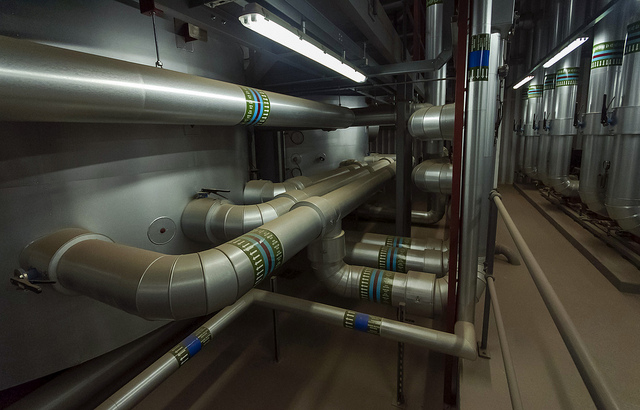By Natalie Hildt Treat | Mon, December 21, 15
The industrial sector represents more than 40 percent of total energy use in the buildings sector, spending more than $20 billion annually in the Northeast/Mid-Atlantic region alone. Industrial efficiency programs have some of the lowest cost of saved energy, meeting demand for as little as 3 ¢/kwh. Yet it is estimated that only 46 percent of industrial facilities engage in energy efficiency programs — leaving a substantial untapped potential on the table.
In our region, many efficiency program administrators (PAs) have been delivering award-winning commercial and industrial (C&I) efficiency programs for decades, and are continually striving to advance program content and delivery strategies. However, there are a number of barriers to participation in efficiency programs, including the need for management buy-in and dedicated upfront investment, complex and proprietary processes, as well as prioritization by facility managers. Energy efficiency is often a hidden resource, competing against other business needs for time and money.
Finding ways to reach and better serve more large customers, in ways that satisfy their business needs, is crucial for many reasons; one of which is that if large customers don’t feel they get high value from the programs, they are less likely to participate may seek ways to “opt out.” When this happens, decreased budgets risk undermining program offerings for all business customers, and mean that less efficiency happens overall.
 Sharing and implementing programmatic best practices and gaining understanding and support from policymakers will help ensure success. To that end, we encourage program administrators and policymakers alike to read and incorporate learnings from some great resources from the State and Local Energy Efficiency Action Network (SEE Action). Two recent papers are chock full of insights and practical guidance based on real experiences from around the country.
Sharing and implementing programmatic best practices and gaining understanding and support from policymakers will help ensure success. To that end, we encourage program administrators and policymakers alike to read and incorporate learnings from some great resources from the State and Local Energy Efficiency Action Network (SEE Action). Two recent papers are chock full of insights and practical guidance based on real experiences from around the country.
Designing Effective Programs for the Industrial Sector describes elements of Successful Industrial Energy Efficiency (IEE) Program Design, providing these recommendations for PAs:
- Clearly demonstrate the value proposition of IEE projects to companies.
- Develop long-term relationships with industrial customers that include continual joint efforts to identify IEE projects.
- Ensure program administrators have industrial sector credibility and offer quality technical expertise.
- Offer a combination of prescriptive and custom options to best support diverse customer needs to provide flexible choices to industry.
- Accommodate scheduling concerns to meet industry project scheduling.
- Streamline and expedite application processes.
- Conduct continual and targeted program outreach.
- Leverage partnerships with federal, state, and regional agencies and organizations.
- Set medium- to long-term goals as an investment signal for industrial customers.
- Undertake proper project measurement and verification and completing program evaluations.
A new paper released this fall has excellent real-world examples of where good program design and implementation come together to deliver sustained success and high levels of customer satisfaction. NEEP encourages PAs and policymakers to take a look at Sustained Energy Savings Achieved through Successful Industrial Customer Interaction with Ratepayer Programs: Case Studies. Here are further recommendations for PAs, based on what has worked best around the country:
- Develop multiple-year relationships between the utility/PA and industrial company personnel, involving a steadily evolving program of support and efforts to identify multiple projects over time (rather than a single project).
- Develop programs that can target energy efficiency gains in manufacturing processes, in addition to energy used in support systems.
- Develop programs involving Strategic Energy Management (SEM) that support internal company platforms for continual identification and implementation of energy savings measures, high-impact and low-cost behavioral changes, and operational and maintenance improvements.
- Promote smart manufacturing and enhanced metering practices, such as installing sensors and embedding devices in software that communicate with one another and with other systems through networks.
Policymaker Understanding & Support is Vital
State energy offices and regulators can support program administrators’ success through high expectations, performance incentives, and flexibility to try new delivery models. To that end, NEEP offers a few more ideas for policymakers to consider:
 Encourage energy efficiency program administrators to set aggressive savings targets for the large commercial and industrial sector, with commensurate budgets, focused marketing and appropriate evaluation, measurement and verification (EM&V).
Encourage energy efficiency program administrators to set aggressive savings targets for the large commercial and industrial sector, with commensurate budgets, focused marketing and appropriate evaluation, measurement and verification (EM&V).
- Avoid taking an overly narrow view of cost-effectiveness, encouraging the PAs to quantify the non-energy benefits (NEBs) that may come along with saving electricity and natural gas. These may include reduced operating and maintenance expenses, water savings, improved worker satisfaction, health and productivity.
- Afford flexibility with things like rolling program budgets, taking into consideration the fact that more involved customer engagement approaches (e.g. multi-year MOUs, Strategic Energy Management) often have long lead times and can take years to fully realize savings.
- Encourage PAs to explore and pilot new program approaches to deliver industrial programs, in particular Strategic Energy Management, energy monitoring and management software, and greater use of sub-metering and incentives for comprehensive, whole-facility performance.
- Understand that non-measure programs and services, including technical expertise and information systems, deliver valued benefits to customers and help ensure continuous engagement and operational efficiency gains. They also serve as a gateway to participation in shared investment opportunities, including traditional rebate programs.
More efficient and productive businesses help states keep a competitive edge, grow jobs and support a thriving economy — all while reducing wasted energy and emissions. But without innovative programs that are responsive to the needs of large customers in particular, their potential to deliver a range of benefits cannot be fully met. Policymakers can play an important role in supporting the efforts of efficiency program administrators to strive for ambitious targets and reach all customers, continuously driving deeper for savings potential. Look for an expanded view of the future of C&I programs in NEEP’s 2016 Regional Roundup, to be released in February 2016.
NEEP is one of six Regional Energy Efficiency Organizations (REEOs), as designated by the U.S. Department of Energy, to provide technical guidance and support to states. For more information on the SEE Action resources or other guidance materials, please contact: Natalie Treat, ntreat@neep.org.
Additional SEE Action Resources
New Paper Explores Role of EE Financing with Examples from MA, CT, NY & MD
In case you missed it, here is yet another terrific new guidance paper from the SEE Action Network:
Making it Count: Understanding the Value of Energy Efficiency Financing Programs Funded by Utility Customers lays the groundwork for a dialogue to explore regulatory and policy mechanisms for ensuring that efficiency financing initiatives provide value for society and protection for consumers. Through case studies of Connecticut, New York, Massachusetts, California, and Maryland, it explores emerging issues that jurisdictions will need to tackle when considering an increased reliance on financing, including:
- Can financing be placed in a regulatory context that would preserve accountability while providing sufficient flexibility to program administrators and customers?
- Can the tools that have been used to screen traditional EE programs for cost-effectiveness and assess potential savings and impacts be adapted in ways that make them work for EE financing programs?
In some jurisdictions, policymakers are considering large-scale financing programs that use utility customer funds to attract larger amounts of private capital. In some cases these strategies support a goal to shift away from traditional energy efficiency program strategies (such as rebates and technical assistance/audits) and towards financing over time. But unique aspects of financing programs may create challenges in adapting traditional regulatory planning, evaluation, and performance tools that are used to assess the impacts and cost-effectiveness of efficiency programs (such as potential studies, cost-effectiveness screening, and impact evaluation).
This report was developed by Lawrence Berkeley National Laboratory's Electricity Markets and Policy Group for SEE Action's Financing Solutions and Ratepayer-Funded Efficiency Working Groups.